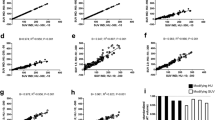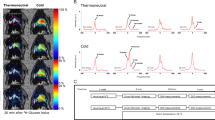Abstract
Background
Brown adipose tissue (BAT) is identified in mammals as an adaptive thermogenic organ for modulation of energy expenditure and heat generation. Human BAT may be primarily composed of brown-in-white (BRITE) adipocytes and stimulation of BRITE may serve as a potential target for obesity interventions. Current imaging studies of BAT detection and characterization have been mainly limited to PET/CT. MRI is an emerging application for BAT characterization in healthy children.
Objective
To exploit Dixon and diffusion-weighted MRI methods to characterize cervical-supraclavicular BAT/BRITE properties in normal-weight and obese children while accounting for pubertal status.
Materials and methods
Twenty-eight healthy children (9–15 years old) with a normal or obese body mass index participated. MRI exams were performed to characterize supraclavicular adipose tissues by measuring tissue fat percentage, T2*, tissue water mobility, and microvasculature properties. We used multivariate linear regression models to compare tissue properties between normal-weight and obese groups while accounting for pubertal status.
Results
MRI measurements of BAT/BRITE tissues in obese children showed higher fat percentage (P < 0.0001), higher T2* (P < 0.0001), and lower diffusion coefficient (P = 0.015) compared with normal-weight children. Pubertal status was a significant covariate for the T2* measurement, with higher T2* (P = 0.0087) in pubertal children compared to prepubertal children. Perfusion measurements varied by pubertal status. Compared to normal-weight children, obese prepubertal children had lower perfusion fraction (P = 0.003) and pseudo-perfusion coefficient (P = 0.048); however, obese pubertal children had higher perfusion fraction (P = 0.02) and pseudo-perfusion coefficient (P = 0.028).
Conclusion
This study utilized chemical-shift Dixon MRI and diffusion-weighted MRI methods to characterize supraclavicular BAT/BRITE tissue properties. The multi-parametric evaluation revealed evidence of morphological differences in brown adipose tissues between obese and normal-weight children.


Similar content being viewed by others
References
National Heart, Lung and Blood Institute (1998) Clinical guidelines on the identification, evaluation, and treatment of overweight and obesity in adults — the evidence report. National Institutes of Health. Obes Res 2:51S–209S
Van Marken Lichtenbelt WD, Vanhommerig JW, Smulders NM et al (2009) Cold-activated brown adipose tissue in healthy men. N Engl J Med 360:1500–1508
Saito M, Okamatsu-Ogura Y, Matsushita M et al (2009) High incidence of metabolically active brown adipose tissue in healthy adult humans: effects of cold exposure and adiposity. Diabetes 58:1526–1531
Saito M (2013) Brown adipose tissue as a regulator of energy expenditure and body fat in humans. Diabetes Metab J 37:22–29
Lee P, Zhao JT, Swarbrick MM et al (2011) High prevalence of brown adipose tissue in adult humans. J Clin Endocrinol Metab 96:2450–2455
Virtanen KA, Lidell ME, Orava J et al (2009) Functional brown adipose tissue in healthy adults. N Engl J Med 360:1518–1525
Lee P, Greenfield JR, Ho KK et al (2010) A critical appraisal of the prevalence and metabolic significance of brown adipose tissue in adult humans. Am J Physiol Endocrinol Metab 299:E601–606
Yoneshiro T, Aita S, Matsushita M et al (2011) Brown adipose tissue, whole-body energy expenditure, and thermogenesis in healthy adult men. Obesity 19:13–16
Vijgen GH, Bouvy ND, Teule GJ et al (2011) Brown adipose tissue in morbidly obese subjects. PLoS One 6, e17247
Vosselman MJ, Brans B, van der Lans AA et al (2013) Brown adipose tissue activity after a high-calorie meal in humans. Am J Clin Nutr 98:57–64
Van der Lans AA, Hoeks J, Brans B et al (2013) Cold acclimation recruits human brown fat and increases nonshivering thermogenesis. J Clin Invest 123:3395–3403
Chondronikola M, Volpi E, Borsheim E et al (2014) Brown adipose tissue improves whole-body glucose homeostasis and insulin sensitivity in humans. Diabetes 63:4089–4099
Lee P, Smith S, Linderman J et al (2014) Temperature-acclimated brown adipose tissue modulates insulin sensitivity in humans. Diabetes 63:3686–3698
Cypess AM, Lehman S, Williams G et al (2009) Identification and importance of brown adipose tissue in adult humans. N Engl J Med 360:1509–1517
Sharp LZ, Shinoda K, Ohno H et al (2012) Human BAT possesses molecular signatures that resemble beige/brite cells. PLoS One 7, e49452
Lidell ME, Betz MJ, Dahlqvist Leinhard O et al (2013) Evidence for two types of brown adipose tissue in humans. Nat Med 19:631–634
Giralt M, Villarroya F (2013) White, brown, beige/brite: different adipose cells for different functions? Endocrinology 154:2992–3000
Beranger GE, Karbiener M, Barquissau V et al (2013) In vitro brown and “brite”/”beige” [sic] adipogenesis: human cellular models and molecular aspects. Biochim Biophys Acta 1831:905–914
Gelfand MJ, O’Hara SM, Curtwright LA et al (2005) Pre-medication to block [(18)F]FDG uptake in the brown adipose tissue of pediatric and adolescent patients. Pediatr Radiol 35:984–990
Bar-Sever Z, Keidar Z, Ben-Barak A et al (2007) The incremental value of 18F-FDG PET/CT in paediatric malignancies. Eur J Nucl Med Mol Imaging 34:630–637
Drubach LA, Palmer EL 3rd, Connolly LP et al (2011) Pediatric brown adipose tissue: detection, epidemiology, and differences from adults. J Pediatr 159:939–944
Gilsanz V, Smith ML, Goodarzian F et al (2012) Changes in brown adipose tissue in boys and girls during childhood and puberty. J Pediatr 160:604–609
Ponrartana S, Hu HH, Gilsanz V (2013) On the relevance of brown adipose tissue in children. Ann N Y Acad Sci 1302:24–29
Hu HH, Perkins TG, Chia JM et al (2013) Characterization of human brown adipose tissue by chemical-shift water-fat MRI. AJR Am J Roentgenol 200:177–183
Hu HH, Smith DL Jr, Nayak KS et al (2010) Identification of brown adipose tissue in mice with fat-water IDEAL-MRI. J Magn Reson Imaging 31:1195–1202
Hu HH, Tovar JP, Pavlova Z et al (2012) Unequivocal identification of brown adipose tissue in a human infant. J Magn Reson Imaging 35:938–942
Hu HH, Yin L, Aggabao PC et al (2013) Comparison of brown and white adipose tissues in infants and children with chemical-shift-encoded water-fat MRI. J Magn Reson Imaging 38:885–896
Rasmussen JM, Entringer S, Nguyen A et al (2013) Brown adipose tissue quantification in human neonates using water-fat separated MRI. PLoS One 8, e77907
Le Bihan D (2008) Intravoxel incoherent motion perfusion MR imaging: a wake-up call. Radiology 249:748–752
Marshall WA, Tanner JM (1969) Variations in pattern of pubertal changes in girls. Arch Dis Child 44:291–303
Marshall WA, Tanner JM (1970) Variations in the pattern of pubertal changes in boys. Arch Dis Child 45:13–23
Deng J, Miller FH, Salem R et al (2006) Multishot diffusion-weighted PROPELLER magnetic resonance imaging of the abdomen. Invest Radiol 41:769–775
Ren J, Dimitrov I, Sherry AD et al (2008) Composition of adipose tissue and marrow fat in humans by 1H NMR at 7 tesla. J Lipid Res 49:2055–2062
Deng J, Fishbein MH, Rigsby CK et al (2014) Quantitative MRI for hepatic fat fraction and T2* measurement in pediatric patients with non-alcoholic fatty liver disease. Pediatr Radiol 44:1379–1387
Patel J, Sigmund EE, Rusinek H et al (2010) Diagnosis of cirrhosis with intravoxel incoherent motion diffusion MRI and dynamic contrast-enhanced MRI alone and in combination: preliminary experience. J Magn Reson Imaging 31:589–600
Weber DR, Moore RH, Leonard MB et al (2013) Fat and lean BMI reference curves in children and adolescents and their utility in identifying excess adiposity compared with BMI and percentage body fat. Am J Clin Nutr 98:49–56
Hu HH, Hines CD, Smith DL Jr et al (2012) Variations in T(2)* and fat content of murine brown and white adipose tissues by chemical-shift MRI. Magn Reson Imaging 30:323–329
Van Rooijen BD, van der Lans AA, Brans B et al (2013) Imaging cold-activated brown adipose tissue using dynamic T2*-weighted magnetic resonance imaging and 2-deoxy-2-[18F]fluoro-D-glucose positron emission tomography. Invest Radiol 48:708–714
Padhani AR, Liu G, Koh DM et al (2009) Diffusion-weighted magnetic resonance imaging as a cancer biomarker: consensus and recommendations. Neoplasia 11:102–125
Bogner W, Pinker-Domenig K, Bickel H et al (2012) Readout-segmented echo-planar imaging improves the diagnostic performance of diffusion-weighted MR breast examinations at 3.0T. Radiology 263:64–76
Jeong EK, Kim SE, Guo J et al (2005) High-resolution DTI with 2D interleaved multislice reduced FOV single-shot diffusion-weighted EPI (2D ss-rFOV-DWEPI). Magn Reson Med 54:1575–1579
Wilm BJ, Svensson J, Henning A et al (2007) Reduced field-of-view MRI using outer volume suppression for spinal cord diffusion imaging. Magn Reson Med 57:625–630
Acknowledgments
This project was supported through a cooperative research agreement between Ann & Robert H. Lurie Children’s Hospital of Chicago and the Williams Heart Foundation.
Dr. J. L. Josefson is supported by Grant Number K12 HD055884 from the Eunice Kennedy Shriver National Institute of Child Health & Human Development.
Conflicts of interest
None
Author information
Authors and Affiliations
Corresponding author
Rights and permissions
About this article
Cite this article
Deng, J., Schoeneman, S.E., Zhang, H. et al. MRI characterization of brown adipose tissue in obese and normal-weight children. Pediatr Radiol 45, 1682–1689 (2015). https://doi.org/10.1007/s00247-015-3391-z
Received:
Revised:
Accepted:
Published:
Issue Date:
DOI: https://doi.org/10.1007/s00247-015-3391-z




